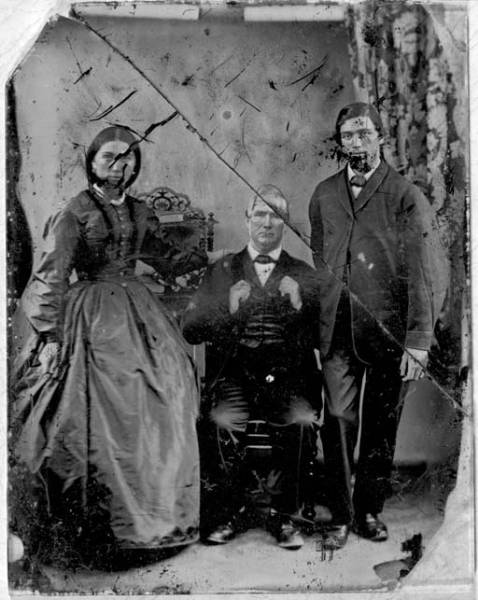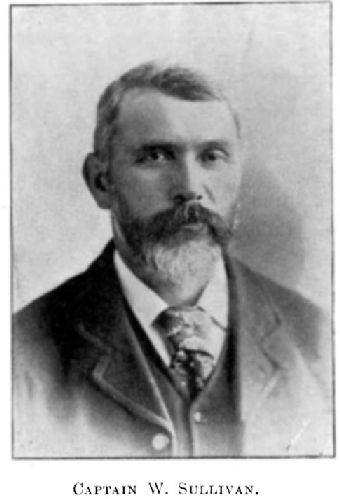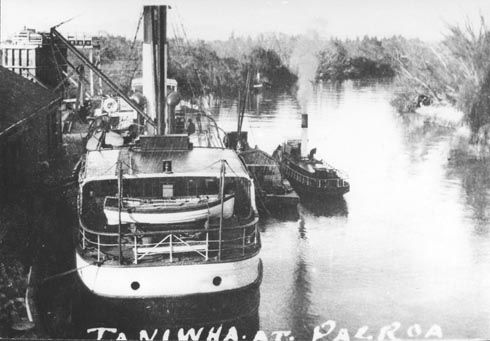Jade River: A History of the Mahurangi
Ronald H LockerFirst published 2001. Published online 2014–. This online edition is a work in progress…
Pages 263–266in printed edition
John Sullivan

John Sullivan of Mahurangi West: Although only labelled thus, it is probable that the two young people are his daughter, Julia, and son, William. image Auckland War Memorial Museum
John Sullivan was the son of Daniel and Sarah (Hands). He was born in London about 1810, but an early photo shows features as Irish as his name. He went to sea, making his first New Zealand landfall in 1832. When he made his second in 1834, after voyages from Hull to Hobart, and Sydney to China, he decided to stay. For ten years he worked in the coastal trade. By 1842 he was half-owner of the schooner Union.
In 1844 Sullivan settled at Mahurangi Heads, and about that year married Merehai of the family of Makoare Ponui at Ōtarawao (probably his daughter). The marriage was not recorded, apparently because it was regarded as a Māori marriage, on which there was no such legal obligation until 1911. Two children were born: Julia in 1846 and William in 1848.
It is said that in 1845 Sullivan was ‘doubled up with rheumatism’, but was completely cured in two months by bathing in the hot springs seeping up through the sands at Waiwera (as Alex Hatfield had been in 1842, and Albin Martin in 1851). Waiwera was destined to play a part in his later life.
Ships were the main business of his life. From 1842 until his death in 1883, he owned thirteen ships, a total only exceeded among River folk by the Kasper family. Most of these were built on the River, often for him, and were engaged in the trade there. He spread his custom broadly over the local shipwrights. The Mahurangi-built ships were: McDougalls’ two schooners, Julia (owned 1849–51) and John (1851–62); Scotts’ cutter Three Sisters (1866–71) and schooners Volunteer (1863) and Rosella (1865); Darrochs’ schooner William and Julia (1861); the Darrach topsail schooner Julia Pryce (1871–6, joint owner with Captain Robert Quinn). In addition he owned the Sydney-built sloop Thomas (1846-9) and a half-share in the Auckland-built cutter Frances (1867–9), well-known for its early River service under Daldy’s ownership. In his later phase as innkeeper at Waiwera, he set up a shipyard there, and the two schooners Waiwera (1875–8) and Telegraph (1876–7) were built for him by the Dunning brothers. He also owned the small paddle steamer Ruby (1877–82). This, his last ship and only excursion into steam, was built by Stone in Auckland in 1876. It served Waiwera and Puhoi. When he sold it, it was converted to screw propulsion and ran to Paeroa, until switched in 1892 to Mangawhai, where it foundered on the bar the next year. Sullivan appears on occasion in the register as builder, but this is a confusion with owner, not uncommon there, and carried over from previous histories.
In his earlier days he skippered some of these ships himself. Pulham listed him among the early cutter captains on the River. His name often appears as skipper in the 1863 shipping notices for this trade. He was recorded as skipper of the Frances in 1868. According to the shipping register, John had an accident-free record. The only occasion where John Sullivan appears as master is at the first registration of the Telegraph in 1876. This was late in his life and may refer to his nephew John of Waiwera, also a mariner, who reappears early in this century as a master under steam.
From Sullivan’s early days, ships were instruments in his other enterprises. In the years 1848–50 he made four applications for licenses to cut firewood, and to cut and saw timber on Crown land at Mahurangi. At that time the limestone strata of the upper River were beginning to be exploited by a number of people, and Sullivan was one of the first. In 1850 he applied for a licence to quarry limestone, and in 1851 to burn it. The crude map accompanying his application, shows his hut and quarry, apparently near the site of Southgate’s first hotel, just below the future cement works. No further record of this enterprise has been found, but it seems likely to have been taken over by John Southgate, who built his first kilns at that spot.

Steamboat Captain: John Sullivan’s son, William, left the family farm at age 24 for the coastal cutter Mahurangi, before taking command of the Rosella—the fourth of eight schooners owned by his father over a period of three decades. Captain William Sullivan commanded at least five different steamers for the Northern Steamship Company, including the Taniwha. image Victoria University of Wellington
According to Pulham, Sullivan, with Robinson as partner, established a whaling station at the Heads about 1853. It seems likely that the whaling experience came from Charles Robinson, who, since he made an old land claim in the Bay of Islands, was an early arrival, and may well have been involved in Bay whaling, or deserted from a whaler. He later became a boatbuilder, in Auckland. George Scott was married in his house in 1860. Robinson was engineer on a Government vessel during the land wars, and skipper of a trading cutter in 1865. Later he went with James Clare to resume boatbuilding in Tonga.
The whaling was a limited success. The Southern Cross of 11 July 1851 reported:
It is a pleasure to note that Mr John Sullivan of Mahurangi succeeded in taking two whales of considerable size in the immediate vicinity of his own dwelling; estimated value £200.
This must have been a flash in the pan, since Pulham adds that ‘they shifted from Mahurangi Heads to the east point of Omaha Harbour; from this move I infer that their success was not very great.’
Sullivan’s ‘own dwelling’ at that time seems to have been in the bay that today bears his name (alternatively, Ōtarawao). It seems he was having major problems in hanging on to it, after rashly attempting to purchase from the local Maori land that had been sold over their heads to the Crown. Te Hemara and his tribe were vigorously reasserting their rights to their traditional lands after the Mahurangi Purchase from the Thames tribes. With the Maori in this mood bringing in a surveyor was a mistake. A report of interpreter Samuel Elliot to the Native Secretary in 1852 states:
I proceeded to Huturiwa, the bay where Mr Sullivan lives at Mahurangi—where Roa, alias George King, pulled away the (surveyor’s) chain with violence and 15 or 16 natives offered the greatest annoyance, threatening Sullivan to pull down his house if he did not side with them, and they would not allow one acre to be laid off from the land, which they admit Sullivan had acquired by ample payment; so that Sullivan expressed a determination to leave the place unless the case is soon investigated and settled.
An accompanying map showed Sullivan’s house in what is unquestionably Ōtarawao Bay. The ‘Roa, alias George King’ was Hori Kingi, a chief of Te Hemara’s tribe, and perhaps the father of ‘Puhoi Roa’, who became William Sullivan’s father-in-law. Te Hemara’s claims were recognised in the grant of the Hemara Reserve, which included Ōtarawao. Sullivan’s claim against Te Hemara and others was the subject of a Land Court hearing in 1855, in which it seems Sullivan was unsuccessful. He never lived there again, although his son did in the next century.
Instead he bought land across the River at the first land sales in 1853. On the first electoral roll of that year he is listed as ‘settler’. The first rating roll of Lower Mahurangi, 1864, shows him as owner of 43 acres on the Eastern Heads (lots 2,3, later Lushingtons’), extending from Dairy Bay to Lagoon Bay, but excluding the lighthouse reserve on the actual Head. His granddaughter, ‘Girlie’, claimed he first lived in a cottage in Dairy Bay with his wife and two young children. The cottage is still there. The chimney and joinery are quite old, although almost everything else has been rebuilt. Rawinia Roa, mother of Sullivan’s daughter-in-law, left a list of who lived where at the Heads about 1864. This makes it clear that Sullivans then lived in Lushingtons Bay. Their house was actually just behind Rodmersham, towards the old reservoir. (The widow Bennett and her children then lived in Dairy Bay). By then it seems Merehai was dead. Her death is not remembered in the family, nor is her grave to be found among the family graves at Te Muri. An old family photo survives of father and teenage son and daughter, without their mother. John never remarried.
A map of first settlers shows that he had also acquired three blocks on the northern shore of the Pukapuka at the 1855 land sales there: lot 83, 80 acres on the boundary of the present McElroy Trust land; lot 119, 115 acres; lot 140, 88 acres, at the head of the creek. The latter two adjoining blocks he sold to John Parry. This land in 1910 became the site of the Glyn dairy factory. Presumably Sullivan worked the timber from this land. His neighbour to lot 83 is written in as ‘J. MacDougal’ (lot 115). It seems reasonable to suppose that his first bespoke ships, the schooners Julia (1849, named for his three-year-old daughter) and John (1851, named for himself) were built there in the Pukapuka for him by Robert and William McDougall, sons of his neighbour. It seems he sold lot 83 to his nephew, Daniel Sullivan junior, who raised a family there late in the century.

Up Another River: One of Captain William Sullivan’s many Northern Steamship Company commands, the Taniwha, up the Waihou River at Paeroa. image Voyager New Zealand Maritime Museum
About 1865 he gave land for a school at Lagoon Bay. His ancestry showed in a stipulation that the school be Catholic, an odd condition considering the predominance of Presbyterians and Anglicans among the shipwrights and settlers whose children it served. The conversion to the faith of its first teacher, Peter Greenhill, was no doubt a bow to his economic need, and without much influence on the curriculum.
In 1870–1, Sullivan was on the Mahurangi East Road Board, so must have been living there, but soon afterwards he moved to Waiwera where his last entrepreneurial phase began, as publican and shipyard owner.
He was proprietor of the Waiwera Hotel by 1875. His predecessor, Webb, was in charge on 4 July 1874, and Sullivan continued until 17 June 1876 when he gave notice that he did not intend to renew his licence. During this time he seems to have been the prime mover in setting up a shipyard there, as part-owner. The Weekly News of 6 March 1875, under a heading ‘Shipbuilding at Waiwera’, observed that ‘Mr Sullivan, proprietor of the Waiwera Hotel, resides on the spot, and he, having been some time in the coasting trade, will be able to see everything carried out to the satisfaction of the firm.’ The other partners are likely to have been Rufus and James Dunning, the actual shipwrights. The recorded products of the yard were the small steam launch Waiwera (1875), unregistered, which served on the Kaipara, and the schooners Waiwera (1875) and Telegraph (1876). As we have seen, Sullivan was the first owner of the two schooners. The festivities accompanying the launching of Telegraph are recorded elsewhere. They also, it seems, marked the end of the yard.
Sullivan returned to the Heads in 1876, and spent his remaining years there. He died of cancer in Auckland on 20 October 1883, aged 73, and was returned to the Heads for burial. His headstone can be seen, with those of his kin, at Te Muri.
In his memoirs of 1884, Pulham said of Sullivan (and his whaling partner Robinson):
Both these men have now joined the Great Majority: the first named Sullivan, only a few months ago. He was a man of great foresight and succeeded in almost all his undertakings.
